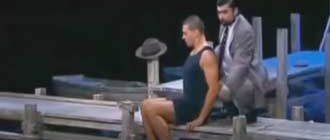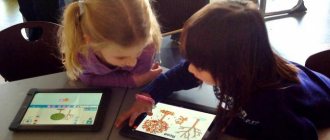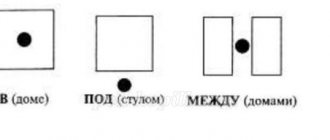Goal: to introduce children to the toys in the room. Age: 3-4 years Program tasks: coherent speech: teach children to compose a short story about a toy with the help of a teacher;
z.k.r: teach clearly, pronounce all words; Dictionary and grammar: teach children to agree words in gender, number and case. Equipment and materials: dolls, cubes, cars, CD by Ekaterina and Sergei Zheleznov “Fun Lessons”.
Progress of the lesson
1. Organizational moment. Teacher: Come closer to me, Look above, below. The toys are sitting here And they are looking at us - Guys, what beautiful and different toys greet us 2. The main part. Games with a doll Toys appear behind the screen: a doll (cries) Doll: Wah-wa-wa Teacher: (Reads the poem “Doll” by G. Boyko) • Who doesn’t know this doll? You won't find a better doll. It immediately opens its eyes, and you just take it in your arms. And even though the doll has no tears, my little girl cries: “Mom, mom!” Where are you, where are you? Well, mom is me. Conversation on speech development “Dolls” - Look around. Find the house where the dolls live - Let's say hello to the dolls (children say hello) - What kind of house do the dolls have? (cozy, spacious, beautiful, clean) - Look into the house, more than one doll lives there. - Let's all come up with names for our dolls together - Tell us what kind of doll you took, what it was wearing, what hair it had, what eyes it had; Game “Rock the dolls” (Sounds of the muses of Ekaterina and Sergei Zheleznov “Fun Lessons” No. 6 “Quiet Doll”) Teacher: Rock the dolls, put them to bed. Games with cubes Teacher: (Reads L. Taktaev’s poem “Cubes”) • Yellow cubes - This is sand, Green cube - Spring forest, Blue cubes - This is a river. There are many cubes - the river is wide. Cube by cube - Floors grow: Kids learn to build houses. Finger gymnastics “Building a wall” Building a wall, - Higher, higher, (We hold our palms straight horizontally in front of us, the little finger of each is looking down, the thumb is up, the inner surface of the palms is facing the chest, alternately we place the “lower” palm on the “upper” one, imitating brickwork) - We've already reached the roof! (Palms folded into a “roof”, tips of middle fingers touching) - Higher, higher, higher! (Folded hands reach up) Conversation on speech development “Cubes” - Look where the cubes and bricks live - Guys, take one cube or brick, what color is it? - How many parts do you have? (one) - How many parts are there together? (a lot) Game “Build whatever you want from cubes” Teacher: Construction parts like it when there are a lot of them. When they are all together, they can make interesting buildings. Now let's put the cubes in our house. Playing with cars. Teacher: Guys, look where the cars live? (in the garage) - What kind of cars are in the garage? (big, small, blue, red, etc.) - But the girl Marina does not know how to play with the car Toy theater show (V. Berestov “About the car”) Here is the girl Marina, And here is her car. - Here, car, cup, Eat, car, porridge. Here's your crib. Sleep, sweet machine! I treasure you, I don’t lead you on. So that you don't get tired, So that you don't catch a cold, So that you don't run around in the dust, Sleep, machine, don't be naughty! Suddenly the car got sick: She didn’t drink, she didn’t eat, she didn’t sit on the bench, she didn’t play, she didn’t sleep, she wasn’t happy. Mishka visited the sick woman and treated her to “Mishka” candy. The doll Katya came in a clean white robe, Katya did not close her eyes over the patient for a whole hour. The doctor knows everything in the world. First-class doctor - Petya (Petya graduated from first grade). And the doctor saved the car. The doctor listened to the patient, Freight, Clockwork, shook his head and said: - Why does the body hurt? He cannot live without cargo. Because the engine has a cold, Because the engine needs air. Tired of living without anything to do, - And the car got sick. She doesn't need silence, She needs movement. How can we save the patient? Take the key and start it! Game “Ride the Car” (Children choose the car they like and roll it on the rug) - Guys, do you think cars will like to live somewhere under the table, under the radiator? (no) 3. Summary of the lesson. - I also think that I won’t like it, because every toy loves its own house. Let's now put all the toys in their places. — Dolls live, where? (in the dollhouse) - Cubes, where do they live? (in the box) - Cars, where do they live? (in the garage)
MAGAZINE Preschooler.RF
Integrative lesson for children 3-4 years old on the topic: “Parts of the day”Municipal autonomous preschool institution "Kindergarten No. 1 "Swallow" of the city of Guryevsk"
Teacher Martynova Lyudmila Anatolyevna
Teacher Kononova Tatyana Viktorovna
Direct educational activities in mathematics and visual arts are aimed at children of the second junior group mastering knowledge about the parts of the day, about different emotional states of a person, and about the possibility of conveying the character of an image with a spot of color.
Keywords: parts of the day, sun, morning, evening, day, night, sad, joyful, sunny bunny.
Preschool age is the most important stage in the development of a child’s personality. Revealing the child’s individuality, developing his creative potential based on self-expression, self-development, cooperation and co-creation is the priority task of the teacher.
This problem is solved in the process of developing educational areas in an integrated manner. The combination of these areas makes it possible to ensure the comprehensive development of the personality of preschoolers. When conducting organized educational activities, the following principles were observed:
- careful selection of didactic and artistic material, depending on the age capabilities of children
- active inclusion of children in a variety of activities: gaming, artistic and speech, cognitive, visual;
- creating an emotional positive climate;
- individual approach to each child, taking into account his preferences, inclinations, interests;
- using a variety of methods and techniques in working with children, including games.
This organized educational activity was highly appreciated by colleagues and parents of students at an open viewing in a preschool institution.
The summary will help preschool teachers enrich the content of work with children of the second younger group, satisfy their need for knowledge, creation and creativity.
Types of children's activities: productive, cognitive-research, communicative, motor, artistic creativity, perception of fiction.
Integration of educational areas: “Cognition” , “Artistic Creativity” , “Communication” , “Physical Education” .
Goals of teachers:
- Form an idea of the parts of the day
- Develop thinking, attention, imagination and visual perception
- Introduce people to different emotional states
- Teach color spots to convey the character of an image, work with didactic material
- To cultivate moral and aesthetic personality traits in children.
Planned results of mastering the content of the educational area “Cognition” : the child orients himself in the parts of the day, receives a system of knowledge about objects and phenomena.
The planned result of mastering the content of the educational field “Artistic Creativity” : the child conveys the character of the image with a color spot, shows accuracy in the process of doing work, and independence.
Planned results of integrative qualities: the child is interested in what is new in the world around him, is able to act independently, takes an active part in the educational process, knows how to work according to rules and patterns, accepts independently acquired knowledge and methods of activity.
Materials and equipment:
- demonstration material: Teddy bear (toy), stand with shelves, pictures depicting parts of the day, model of the sun, easel, brush, yellow gouache, mirror
- handouts: cards depicting parts of the day, sheets of paper, yellow gouache, brushes
- audio recording: sounds of living nature.
Methods and techniques:
- Verbal: artistic expression, leading question, problem situation, TRIZ, verbal instruction, verbal game;
- Visual: surprise moment, examination;
- Practical: working with didactic material, drawing;
- Games: “sunny bunny” , “Day and night” , “Walk in nature” .
Progress of the lesson:
I. Organizational moment.
Educator: - Get into a circle, let's wake up our fingers (finger game)
“The fingers played hide-and-seek And the heads were removed. Like this, like this And the heads were removed. The fingers began to count 1, 2, 3, 4, 5 and the fingers went to sleep. Suddenly they woke up, perked up and began to play. They are so friendly. They are so necessary.
II. Introduction to the topic.
Educator: - Guys, look who came to us (approaches Mishka)
Educator: - Bear, why are you so sad? What's happened?
Bear: - I was asked to put the pictures in order on a shelf, but I don’t know how to do it correctly. Help me please.
Educator: - Shall we help Mishka complete the task? (go to the stand on which one demonstration picture is placed, containing the main features of the parts of the day - morning, afternoon, evening, night).
Educator: - But in order to help “Mishka” , we ourselves must figure it out and complete the task without errors. We'll figure out?
Educator: - I looked carefully at these pictures and saw something in common. Do you see? (if they don’t answer, ask a riddle).
“Without me, there will be no light. Without me, there will be no summer. In the mornings, I knock on the windows, Wake up, it’s risen...” (sun)
Show the model of the sun.
“In the morning the sun rises, calls everyone to the street, I leave the house. Hello, sun, it’s me!”
Educator: - Guys, say hello to the sun.
III. Working with handouts.
Educator: - Guys, when does this happen?
Morning woke up
The sun has risen
Everyone woke up and stretched.
Let's think about what we do in the morning (get up, wash, go to kindergarten, do gymnastics, have breakfast).
Educator: - Well done! Do we now know which pictures we need to put on the first shelf? Let's help Mishka (children choose the right pictures from all those lying on the table and put them on 1 shelf, individual work).
Educator: - Meanwhile, the sun rises higher and higher. Show how it rises high (children rise on their toes, stretch their arms as high as possible).
Educator: - The day comes and the sun calls us to go for a walk. Let's take a walk, breathe some fresh air, straighten our shoulders. There are many flowers in the clearing, lean over and smell them. What a wonderful scent.
Educator: - What else do we do during the day? (working out, walking, playing, having lunch, napping) Guys, can we find the right pictures? We continue to help Mishka (children choose pictures and put them on the 2nd shelf, individual work)
Educator: - The sun worked all day and warmed everyone up.
“Sun, well done sun,
It worked out in the end.”
What do we tell the sun for his work? (children thank the sun).
“I’ve worked since the morning, it’s time to rest.” The sun goes down and it comes... (evening)
Educator: - What are we doing in the evening? (we go home from kindergarten, read, watch the program “Good night, kids” )
Educator: - Everything we just said will be found in the pictures and put on the shelf (individual work)
Then turn on the audio recording “Tired toys are sleeping”
Educator: - The toys sleep, the sun sleeps, the children sleep and it comes... (night)
Educator: - The sun fell asleep, and stars and the moon appeared in the sky. Let's display the remaining pictures (individual work).
Imperceptibly attach a smile to Mishka.
Educator: - Do you think we helped Mishka arrange the pictures correctly? Have you noticed that his mood has changed? There was a bear... (sad), and now... (cheerful)
He smiles, you and I smile too. What's your mood now?
Fine Arts teacher: - We now have another cheerful guest. Do you know his name? ( a “sunny bunny” and jumps along the walls).
Fine Arts teacher: - That's right, this is a sunny bunny, the sun's younger brother. He will definitely cheer up the gloomiest person. Look how he jumps around the group. Try to catch it (children catch a “sunny bunny” ).
The teacher, taking advantage of the fact that the “sunny bunny” jumped onto the easel, says: “Now I’ll catch you,” and with a quick movement of the brush draws a bright yellow spot. Then the “bunny” begins to jump on the leaves laid out on the tables. Children try to “catch sunbeams” and draw them on their pieces of paper.
Art teacher: - Well done, guys! You have caught the “sunny spot” now, as soon as you are in a bad mood, you can look at your drawing, and then all the grievances will be forgotten and your soul will feel happier!
Music used in class:
"Morning" E. Grieg,
“Polka” S.V. Rachmaninov,
“Overture “The Nutcracker” by P.I. Chaikovsky,
“Svetlana’s Lullaby” by T. Khrennikov
| Next > |
Hello world, Part 1, 3-4 years, Kochemasova E.E., 2016
Hello, world, Part 1, 3-4 years, Kochemasova E.E., 2016. The textbook is intended for the cognitive development of children 3-4 years old. It is an integral part of the educational complex “Hello, world!” for preschool children and the initial element of a continuous author's course on the world around us (authors A.A. Vakhrushev and others), as well as an integral part of a set of manuals that implement the Basic Educational Program “Kindergarten 2100”. Provides an integrated approach to solving the problems of the Federal State Educational Standard for preschool education. The textbook is focused on the development of the child’s personality, his creative abilities, and on the formation of a holistic picture of the world. Can be used in preschool educational organizations, school preparation groups, as well as for individual work of parents with children. All texts included in this textbook are not intended for children to read; they are read by adults (teachers, parents). Examples. Find a pair of mittens. Trace the mittens on your right hand with a red pencil, and on your left with a blue pencil. Look carefully at the pictures in the bottom row. Find exactly the same drawings in the remaining rows and color them according to the sample. Color the pictures in the same color as the frog. Circle what is always green. Content. SUMMER. JOURNEY TO A GREEN COUNTRY. WILD ANIMALS. JOURNEY TO THE RED COUNTRY. JOURNEY TO THE YELLOW COUNTRY. JOURNEY TO THE ORANGE COUNTRY. AUTUMN. PLANTS. VEGETABLES. FRUITS. WHO ARE WE? WHO ARE WE? WHAT ARE WE? PETS. JOURNEY TO THE BLUE COUNTRY. JOURNEY TO THE PURPLE COUNTRY. RED - BLUE - PURPLE. COLORED WORLD. PARTS OF THE DAY. WINTER. BIRDS. OUR LITTLE BROTHERS. TEA CARE. TABLEWARE AND KITCHENWARE. FURNITURE. CLOTH. SHOES. GO SHOPPING. JOURNEY TO THE BLUE COUNTRY. SPRING. SEASONS. REPETITION. Methodological comments for parents.
Download the e-book for free in a convenient format, watch and read: - fileskachat.com, fast and free download.
Below you can buy this book at the best price with a discount with delivery throughout Russia. Buy this book
How to open a file
Copyright holders
- pdf - Yandex.Disk.
Publication date: 10/23/2018 14:10 UTC
books for children :: Kochemasova
See also textbooks, books and educational materials:
- Games in our yard, 50 best games, Krupenskaya N., 2017
- Fun company, 100 dots, Connect and draw, Volchenko Y.S., 2018
- Toy-step to school, Practical mathematics course for preschoolers, Methodological recommendations, Part 4 (1-2), Peterson L.G., Kochemasova E.E., 2014
- Playing game - a stepping stone to school, Practical mathematics course for preschoolers, Methodological recommendations, Part 4, Peterson L.G., Kochemasova E.E., 2014
The following textbooks and books:
- Gramoteyka, Intellectual development of children 3-4 years old, Zemtsova O.N., 2016
- ABC of Security, Migunova N., 2017
- Smart mosaic, 2017
- Learning to count, Gavrina S.E., Kutyavina N.L., Toporkova I.T., 2008
Previous articles:
- Big book of games for children from 3 to 7 years old, Kozak O.H., 2000
- ABC in verses and pictures, Marshak S.Ya., 2018
- Learn to write correctly, cleanly, beautifully and quickly
- Developing logic, Motor skills, logic, speech, Tumanovskaya M.I., 2003
<< Previous articleNext article >>



